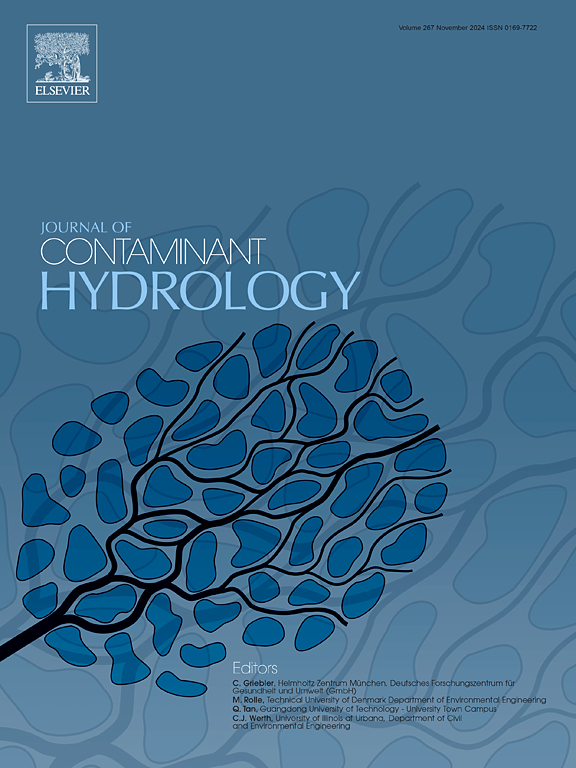Unraveling the fate of phosphorus in alluvial aquifers of the middle-lower Yellow River: Coupled natural and anthropogenic impacts
IF 3.5
3区 环境科学与生态学
Q2 ENVIRONMENTAL SCIENCES
引用次数: 0
Abstract
In recent years, groundwater phosphorus (P) contamination has received increasing attention, yet most studies focus solely on either anthropogenic or geogenic influences. This research addressed the combined effects of human activities and natural processes on P enrichment in the middle-lower Yellow River basin, where dissolved inorganic phosphorus (DIP) concentrations reached 0.59 mg/L. Hydrogeochemical analysis, along with multiple statistical methods and the Redfield ratio, revealed that geogenic processes were the dominant drivers of groundwater P enrichment, accounting for 77.5 % of the samples, while anthropogenic activities, particularly intensive agriculture, densely residential area and industrial development, contributed to P inputs in 22.5 % of the samples. Further analysis using dual isotopes (δ13C-DIC and δ56Fe) demonstrated that OP mineralization was the dominant geogenic P enrichment process, with the reductive dissolution of P-rich iron minerals serving as a secondary contributor. A comparative analysis between the middle-lower Yellow River basin and the central Yangtze River basin highlighted that the abundance of natural P-containing carriers and the closed or open nature of the groundwater environment jointly determined the extent of geogenic and anthropogenic P enrichment. This study provides valuable insights into the coupled impacts of natural and anthropogenic factors, enhancing our understanding of groundwater P dynamics.
揭示黄河中下游冲积含水层中磷的命运:自然和人为影响的耦合
近年来,地下水磷污染受到越来越多的关注,但大多数研究都集中在人为或地质影响上。黄河中下游流域溶解无机磷(DIP)浓度达到0.59 mg/L,研究了人类活动和自然过程对P富集的综合影响。水文地球化学分析以及多种统计方法和Redfield比值表明,地质过程是地下水P富集的主要驱动因素,占77.5%,而人类活动,特别是集约化农业,密集的住区和工业发展,贡献了22.5%的样品的P输入。双同位素(δ13C-DIC和δ56Fe)分析表明,OP矿化是主要的成矿P富集过程,富P铁矿物的还原溶蚀作用是次要的富集作用。黄河中下游与长江中部的对比分析表明,天然含磷载体的丰度和地下水环境的封闭或开放共同决定了地质和人为富集P的程度。该研究为自然和人为因素的耦合影响提供了有价值的见解,增强了我们对地下水磷动力学的认识。
本文章由计算机程序翻译,如有差异,请以英文原文为准。
求助全文
约1分钟内获得全文
求助全文
来源期刊

Journal of contaminant hydrology
环境科学-地球科学综合
CiteScore
6.80
自引率
2.80%
发文量
129
审稿时长
68 days
期刊介绍:
The Journal of Contaminant Hydrology is an international journal publishing scientific articles pertaining to the contamination of subsurface water resources. Emphasis is placed on investigations of the physical, chemical, and biological processes influencing the behavior and fate of organic and inorganic contaminants in the unsaturated (vadose) and saturated (groundwater) zones, as well as at groundwater-surface water interfaces. The ecological impacts of contaminants transported both from and to aquifers are of interest. Articles on contamination of surface water only, without a link to groundwater, are out of the scope. Broad latitude is allowed in identifying contaminants of interest, and include legacy and emerging pollutants, nutrients, nanoparticles, pathogenic microorganisms (e.g., bacteria, viruses, protozoa), microplastics, and various constituents associated with energy production (e.g., methane, carbon dioxide, hydrogen sulfide).
The journal''s scope embraces a wide range of topics including: experimental investigations of contaminant sorption, diffusion, transformation, volatilization and transport in the surface and subsurface; characterization of soil and aquifer properties only as they influence contaminant behavior; development and testing of mathematical models of contaminant behaviour; innovative techniques for restoration of contaminated sites; development of new tools or techniques for monitoring the extent of soil and groundwater contamination; transformation of contaminants in the hyporheic zone; effects of contaminants traversing the hyporheic zone on surface water and groundwater ecosystems; subsurface carbon sequestration and/or turnover; and migration of fluids associated with energy production into groundwater.
 求助内容:
求助内容: 应助结果提醒方式:
应助结果提醒方式:


